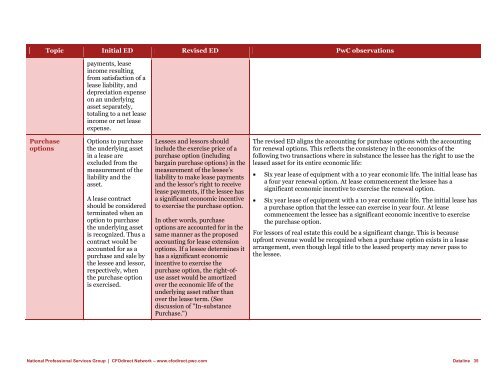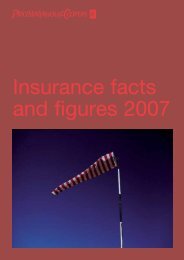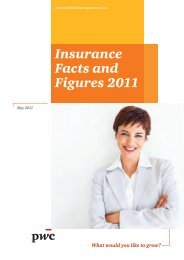Dataline A look at current financial reporting issues - PwC
Dataline A look at current financial reporting issues - PwC
Dataline A look at current financial reporting issues - PwC
Create successful ePaper yourself
Turn your PDF publications into a flip-book with our unique Google optimized e-Paper software.
Topic Initial ED Revised ED <strong>PwC</strong> observ<strong>at</strong>ions<br />
payments, lease<br />
income resulting<br />
from s<strong>at</strong>isfaction of a<br />
lease liability, and<br />
depreci<strong>at</strong>ion expense<br />
on an underlying<br />
asset separ<strong>at</strong>ely,<br />
totaling to a net lease<br />
income or net lease<br />
expense.<br />
Purchase<br />
options<br />
Options to purchase<br />
the underlying asset<br />
in a lease are<br />
excluded from the<br />
measurement of the<br />
liability and the<br />
asset.<br />
A lease contract<br />
should be considered<br />
termin<strong>at</strong>ed when an<br />
option to purchase<br />
the underlying asset<br />
is recognized. Thus a<br />
contract would be<br />
accounted for as a<br />
purchase and sale by<br />
the lessee and lessor,<br />
respectively, when<br />
the purchase option<br />
is exercised.<br />
Lessees and lessors should<br />
include the exercise price of a<br />
purchase option (including<br />
bargain purchase options) in the<br />
measurement of the lessee’s<br />
liability to make lease payments<br />
and the lessor’s right to receive<br />
lease payments, if the lessee has<br />
a significant economic incentive<br />
to exercise the purchase option.<br />
In other words, purchase<br />
options are accounted for in the<br />
same manner as the proposed<br />
accounting for lease extension<br />
options. If a lessee determines it<br />
has a significant economic<br />
incentive to exercise the<br />
purchase option, the right-ofuse<br />
asset would be amortized<br />
over the economic life of the<br />
underlying asset r<strong>at</strong>her than<br />
over the lease term. (See<br />
discussion of "In-substance<br />
Purchase.")<br />
The revised ED aligns the accounting for purchase options with the accounting<br />
for renewal options. This reflects the consistency in the economics of the<br />
following two transactions where in substance the lessee has the right to use the<br />
leased asset for its entire economic life:<br />
Six year lease of equipment with a 10 year economic life. The initial lease has<br />
a four year renewal option. At lease commencement the lessee has a<br />
significant economic incentive to exercise the renewal option.<br />
Six year lease of equipment with a 10 year economic life. The initial lease has<br />
a purchase option th<strong>at</strong> the lessee can exercise in year four. At lease<br />
commencement the lessee has a significant economic incentive to exercise<br />
the purchase option.<br />
For lessors of real est<strong>at</strong>e this could be a significant change. This is because<br />
upfront revenue would be recognized when a purchase option exists in a lease<br />
arrangement, even though legal title to the leased property may never pass to<br />
the lessee.<br />
N<strong>at</strong>ional Professional Services Group | CFOdirect Network – www.cfodirect.pwc.com <strong>D<strong>at</strong>aline</strong> 35

















